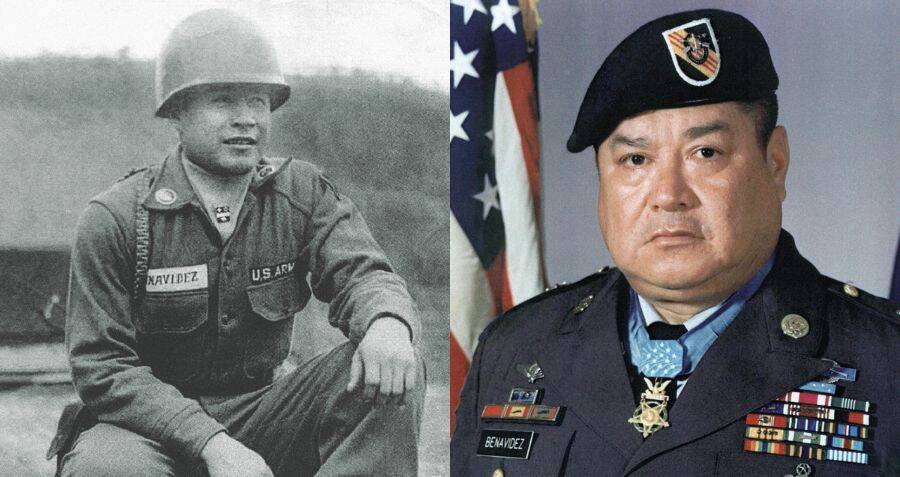The Story of Hero Roy P. Benavidez
Roy P. Benavidez
Master Sergeant
Detachment B-56 (MACV-SOG), 5th Special Forces Group (Airborne), 1st Special Forces
August 5, 1935 – November 29, 1998
Born on August 5, 1935, Benavidez faced adversity from childhood. Orphaned by the age of 7, he found solace in the care of his aunt and uncle. The Texas sun bore witness to his labor in the fields, where he picked sugar beets and cotton to support his family. Despite limited prospects, young Roy had big dreams.
At 17, he joined the Texas National Guard, embarking on a path that would lead him to the heart of heroism. The Korean War beckoned, and Benavidez answered the call. Two years later, he stepped into the active-duty infantry, serving in South Korea and Germany.
Vietnam awaited, and fate dealt its hand. On a fateful patrol, Benavidez encountered a landmine. The explosion left him paralyzed from the waist down. Doctors delivered grim news: walking might forever elude him. But Roy Benavidez was no ordinary man.
Fort Bragg witnessed his metamorphosis. From a man who could barely stand, he evolved into a soldier who could run 10 miles with a rucksack. Special Forces beckoned, and he trained as a weapons expert. In 1967, he returned to Vietnam, ready to face combat.
In April 1968, Benavidez narrowly escaped a patrol with his life thanks to Sgt. 1st Class LeRoy Wright’s intervention. Benavidez and Wright had known each other in the 82nd Airborne Division, gone through Special Forces Selection together, and found themselves reunited in Detachment B-56.
As Benavidez returned from Catholic Mass on May 2, 1968, he heard a panicked call for help over the radio. Benavidez learned that Wright was part of a 12-man team under attack (three Special Forces Soldiers and nine Vietnamese Montagnards, or Mountain Men). Surrounded by a North Vietnamese Army (NVA) Battalion, the team was outnumbered nearly 100 to 1 and three helicopters had already failed to get them out. Without hesitation, Benavidez grabbed a nearby aid bag and armed only with the combat knife on his belt, climbed into the next helicopter to help the rescue attempt.
1968, near Loc Ninh, Cambodia. The jungle echoed with gunfire. A team of American soldiers found themselves trapped, their helicopter unable to land. But Benavidez, fueled by an unyielding spirit, jumped out of the helicopter and directly into – what he would later describe as “six hours in hell.”

Benavidez sprinted about 75 yards toward the stranded team. Bullets tore through his leg, and a hand grenade explosion sprayed his head and face with shrapnel. Yet, he pressed on. Reaching the team, he became the beacon of hope. Benavidez reorganized the remaining forces on the ground. He stabilized the wounded, arming himself with an AK-47 from one of the fallen Montagnards. Amidst chaos, he signaled the helicopters for extraction. With unwavering resolve, he led the walking members of the team to the evacuation choppers, all while suppressing the relentless enemy fire.
Benavidez then took another bullet to the stomach and more shrapnel from another grenade to his back. The pilot of the second helicopter fell, and the aircraft flipped, trapping the rest of the team inside. Severely wounded, Benavidez refused surrender. He moved to the crash site, rallying the survivors. In a desperate bid for survival, he formed a defensive perimeter. Radio in hand, he called for bombing runs by jets and attacks by helicopter gunships. His blood-soaked fingers never wavered. More helicopters landed, whisking away the wounded.

He began once again carrying his wounded comrades onto a helicopter and ensuring that he recovered all maps, Standard Operating Instructions (SOI) cards, notes, and other classified material. On one trip, he was clubbed in the jaw by an NVA soldier and run through with a bayonet. Benavidez killed the soldier with his knife and continued moving injured team members to the helicopter while holding in his intestines, killing two more NVA soldiers who were preparing to kill the helicopter pilot. After a final check to ensure he had left no classified material behind, barely moving and nearly blind from the blood running into his eyes after sustaining 37 wounds, Benavidez allowed himself to be pulled into the helicopter.
Six hours after he first jumped aboard the helicopter, Benavidez felt himself being placed into a body bag, presumed dead. Mustering the last of his strength, unable to speak, move, or open his eyes, he spat in the doctor’s face to convey that he was still alive.
After over a year in various hospitals, Benavidez recovered and was awarded the Distinguished Service Cross (DSC); at the time, the Army believed there was no eyewitness to the account, a requirement at the time to award the Medal of Honor. On Feb. 24, 1981, after finding a living eyewitness, President Ronald Reagan upgraded his DSC to a Medal of Honor.

After serving at Fort Riley, Kansas and Fort Sam Houston, and having reached the rank of master sergeant, Benavidez retired in 1976. He made encouraging and guiding young Americans his priority through public speaking and mentoring, particularly pushing underprivileged children away from gangs and into military service to bring productivity and purpose. In 1983 he fought for his Vietnam War comrades one last time, successfully advocating for the continuation of disability benefits for Vietnam veterans. Roy P. Benavidez died on Nov. 29, 1998 at the age of 63 and was buried at Fort Sam Houston National Cemetery in San Antonio, Texas.

